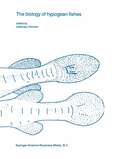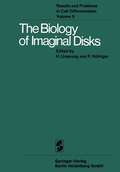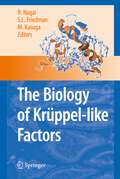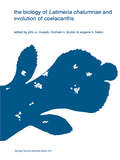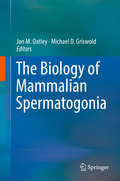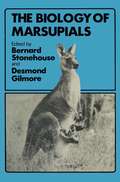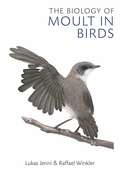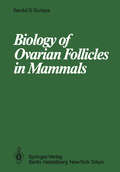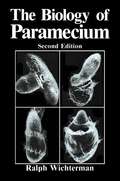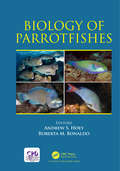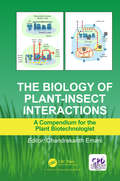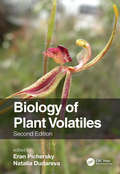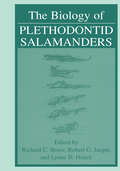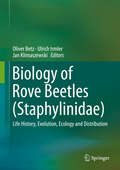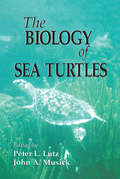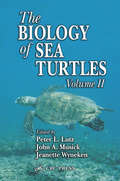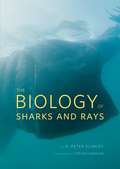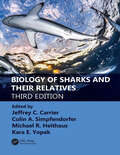- Table View
- List View
The biology of hypogean fishes (Developments in Environmental Biology of Fishes #21)
by Aldemaro RomeroHypogean (cave, artesian) fishes have fascinated researchers even before they were described in the scientific literature in 1842. Since then, a number of scientists have used them to justify their own evolutionary ideas, from neo-Lamarckism to neo-Darwinism, from neutral evolution to selectionist approaches. Research in recent years has shown that these fishes are much more complex in their adaptations to the subterranean environment than previously believed: there are those with features expected from living in total darkness (complete blindness and depigmentation) and poor in nutrients (extremely low metabolic rates); others differ very little, if any, from their epigean (surface) ancestors in their morphology and physiology (but not so in their behavior). Some of them even live in nutrient-rich environments. Actually, one of the most overlooked facets of these animals is that there are more species of hypogean fishes without troglomorphisms (blindness, depigmentation) than with troglomorphic ones. The study of these apparently `unadapted' fishes is providing new insights into our understanding of the evolution of phenotypic characters, founding effect, behavioral, and physiological adaptations. The 86 species of troglomorphic fishes described so far belong to 18 different families, many of which would hardly fit the notion that they were 'preadapted' to conquer the underground environment. Further, many troglomorphic `species' show very little genotypic differentiation when compared with their putative ancestors, indicating that massive phenotype changes can be achieved via little genetic reorganization, a reorganization that mostly affects regulatory genes. These and many other topics are discussed in this volume containing 29 papers, written by 41 authors from 9 countries. Hopefully, this volume will convince many other researchers that hypogean fishes represent a unique opportunity to study a concept in evolutionary biology that is only superficially understood: convergent evolution.
The Biology of Imaginal Disks (Results and Problems in Cell Differentiation #5)
by H. Ursprung R. Nöthiger~o working hypothesis amounts to much until it has been tested on suitable material. Indeed, the choice of an appropriate experimental system has often been the key to the solution of a problem. The present volume is devoted to insect imaginal disks. These groups of larval cells are the primordia of precisely characterized adult counterparts, without apparent function in larvae. At the onset of metamorphosis, the subtle interplay of hormonal signals brings growth to a halt, and differentiation begins. In the fruitfly, a host of mutations are known to affect the development of disks; these provide ample material for analysis. It was largely ERNST HADORN'S ingenuity that directed the attention of many scientists around the world to this promising experimental system, and to him this volume is dedicated. All the contributors have been associated with him at one time or another, as graduate students, postdoctoral fellows, or colleagues. Each author has attempted to cover comprehensively the topic assigned to him. This has inevitably led to some overlapping, for which the editors should be blamed, not the authors, as this results from the way the topic was subdivided at the outset. We believe this volume will be a welcome sourcebook for the specialist in the field, and a provocative monograph for the uninitiated scientist interested in the exciting area of cell determination.
The Biology of Krüppel-like Factors
by Ryozo Nagai Scott L. Friedman Masato KasugaKruppel-like factors (KLFs) are attracting great attention across a wide spectrum of biological sciences and medicine because of their remarkable biological potency and the diversity of roles they play in the physiological and pathological changes of cells and tissues. This book is a comprehensive compendium of the latest research on the molecular mechanisms of KLFs, describing their roles in transcriptional regulation, cellular differentiation and development, the pathogenesis of the liver and cardiovascular systems and cancer, and generation of ES cells and iPS cells. As the only concise treatise written to date by leading experts in the field, it serves as an authoritative review of this family of molecules and is an essential reference for all who are interested in KLFs. The book also explores the potential of KLFs as targets for novel therapeutics and diagnostics, and will be invaluable in those fields.
The biology of Latimeria chalumnae and evolution of coelacanths (Developments in Environmental Biology of Fishes #12)
by J. A. Musick Michael N. Bruton E. K. BalonThe Biology of Mammalian Spermatogonia
by Jon M. Oatley Michael D. GriswoldThis book provides a resource of current understandings about various aspects of the biology of spermatogonia in mammals. Considering that covering the entire gamut of all things spermatogonia is a difficult task, specific topics were selected to provide foundational information that will be useful for seasoned researchers in the field of germ cell biology as well as investigators entering the area. Looking to the future, the editors predict that the foundational information provided in this book -- combined with the advent of new tools and budding interests in use of non-rodent mammalian models -- will produce another major advance in knowledge regarding the biology of spermatogonia over the next decade. In particular, we anticipate that the core molecular machinery driving different spermatogonial states in most, if not all, mammals will be described fully, the extrinsic signals emanating from somatic support cell populations to influence spermatogonial functions will become fully known, and the capacity to derive long-term cultures of SSCs and transplant the population to regenerate spermatogenesis and fertility will become a reality for higher order mammals.
The Biology of Moult in Birds
by Lukas Jenni Raffael WinklerFeathers are amazing structures unique to birds and, for a variety of reasons, they need to be renewed periodically as a whole in a process called moult. During this process, all of the functions of plumage are impaired and most aspects of a bird's life are affected. Every moult determines a bird's appearance anew, and restores plumage efficacy for flight and insulation. Moult profoundly affects physiology and the organization of the annual cycle, and it constrains reproduction and migration. Given these major impacts, which are equal to the other annual challenges of reproduction and migration, it is surprising that research on moult has largely been so neglected a subject. Lukas Jenni and Raffael Winkler have brought together the widely scattered results of studies on the processes and consequences of moult in birds. This book opens with an overview of the functions of plumage, and of feather maintenance and feather wear, and then introduces the two functions of moult: replacement of worn feathers and adjustment of plumage characteristics and appearance. The body of the book then examines feather-growth and the physiology, energetics and control of moult, and how various other physiological processes interact with moult and may compensate for its costs. Significantly, the authors explain how variations in moult and feather quality affect a bird's overall plumage quality, and they highlight the resulting consequences in terms of physical performance, appearance and signalling. Finally, there is a review of all the various solutions that birds have developed to fit moult into the annual cycle.This long-awaited book covers for the first time all aspects of the biology of moult and fills an important gap in the literature, completing our understanding of how the most important annual events in a bird's life fit together into a coherent whole. It draws on a wide range of information – from penguins to small passerines, from raptors to wildfowl – to highlight the variety of the subject and to pinpoint the many gaps in our knowledge along with avenues for fruitful further research.
The Biology of Moult in Birds
by Lukas Jenni Raffael WinklerFeathers are amazing structures unique to birds and, for a variety of reasons, they need to be renewed periodically as a whole in a process called moult. During this process, all of the functions of plumage are impaired and most aspects of a bird's life are affected. Every moult determines a bird's appearance anew, and restores plumage efficacy for flight and insulation. Moult profoundly affects physiology and the organization of the annual cycle, and it constrains reproduction and migration. Given these major impacts, which are equal to the other annual challenges of reproduction and migration, it is surprising that research on moult has largely been so neglected a subject. Lukas Jenni and Raffael Winkler have brought together the widely scattered results of studies on the processes and consequences of moult in birds. This book opens with an overview of the functions of plumage, and of feather maintenance and feather wear, and then introduces the two functions of moult: replacement of worn feathers and adjustment of plumage characteristics and appearance. The body of the book then examines feather-growth and the physiology, energetics and control of moult, and how various other physiological processes interact with moult and may compensate for its costs. Significantly, the authors explain how variations in moult and feather quality affect a bird's overall plumage quality, and they highlight the resulting consequences in terms of physical performance, appearance and signalling. Finally, there is a review of all the various solutions that birds have developed to fit moult into the annual cycle.This long-awaited book covers for the first time all aspects of the biology of moult and fills an important gap in the literature, completing our understanding of how the most important annual events in a bird's life fit together into a coherent whole. It draws on a wide range of information – from penguins to small passerines, from raptors to wildfowl – to highlight the variety of the subject and to pinpoint the many gaps in our knowledge along with avenues for fruitful further research.
Biology of Ovarian Follicles in Mammals
by S.S. GurayaBoth functions of the mammalian ovary, the endocrine and (synthesis and secretion of steroid hormones) and exocrine (production of ova), depend upon the presence and cyclic growth of follicles, as the depletion of primordial follicles from the ovary leads to cessation of these f-unctions or female reproduction in mammals, or to postmenopausal period in humans. Actually, various fertility and sterility problems at the ovarian level are related to follicles. Therefore, a thorough understanding of the biology of ovarian follicles in mammals is of fundamental interest to a wide variety of academic and scientific disciplines. Study of their structure, function, and control involves mor phology, including ultrastructure, cell biology, physiology, endocrinology, biochemis try, immunology, neurobiology and pharmacology. Zoologists take interest in comparative and evolutionary aspects of biology of ovarian follicles in many different groups of mammals. Agricultural scientists and wildlife biologists need a thorough knowledge of the biology of follicles to control more effectively fecundity in domestic animals and endangered species of mammals. Finally, clinical scientists, toxicologists and physicians want to know the normal and pathological features of ovarian follicles in women, especially in relation to health and the regulation of fertility. Having in view the great importance of studying various aspects of biology of ovarian follicles, numerous papers and reviews on several aspects of ovarian follicles are published annually in a wide variety of scientific journals.
The Biology of Paramecium
by R. WichtermanThis completely revised, updated, and expanded edition has been neces sitated by the many important newer discoveries that have been made since the publication of the first edition. That volume contained almost 2000 references from the 1600s to 1953. Since then and after an extensive search, I have accumulated some 3800 additional titles from the world's literature on Paramecium. After certain titles that largely represented abstracts and preliminary reports that were followed by full research papers were eliminated, approximately 4400 full titles from the 1600s to the present were selected for inclusion in this edition. Most of the titles in the Bibliography are the more recent ones beginning with 1953. I consider the Bibliography an important part of the book: A good title of a paper in a journal is a minature abstract of its contents. Thus, the reader who may be interested in obtaining additional information not found in the book may refer directly to the original source. A cursory examination of the Bibliography will reveal that parame cium research has extended into all branches of biology, including bio chemistry and biophysics. Like other areas of science, paramecium research has become highly specialized and fragmented. I have attempted to organize and present the basic information in one book. Because of space limitations, some items may have been dealt with briefly. It is in such instances that the Bibliography will be found to be invaluable.
Biology of Parrotfishes
by Andrew S. Hoey David Roy Bellwood Roberta M. BonaldoParrotfish are found on almost every coral reef in the world. This ubiquity and uniqueness of their feeding action make them one of the most important groups of fishes within coral reef ecosystems. But why, exactly, are parrotfish so important to reefs? Can the evolution of a particular jaw morphology and feeding action really have had such a large impact on the health and functioning of the world's coral reefs? This book introduces the reader to this fascinating group of fishes (Labridae, Scarinae), from the morphological innovation of a jaw that has the power to bite through solid calcium carbonate, to the threats currently faced by parrotfish populations around the world. It contains new insights into their diet and food processing ability, and lifehistories, and concludes with an overview of emerging and future research directions.
Biology of Parrotfishes
by Andrew S. Hoey Roberta M. BonaldoParrotfish are found on almost every coral reef in the world. This ubiquity and uniqueness of their feeding action make them one of the most important groups of fishes within coral reef ecosystems. But why, exactly, are parrotfish so important to reefs? Can the evolution of a particular jaw morphology and feeding action really have had such a large impact on the health and functioning of the world's coral reefs? This book introduces the reader to this fascinating group of fishes (Labridae, Scarinae), from the morphological innovation of a jaw that has the power to bite through solid calcium carbonate, to the threats currently faced by parrotfish populations around the world. It contains new insights into their diet and food processing ability, and lifehistories, and concludes with an overview of emerging and future research directions.
The Biology of Plant-Insect Interactions: A Compendium for the Plant Biotechnologist
by Chandrakanth EmaniOverviews of biochemical, genetic, and molecular perspectives of plant-insect interactions with added emphasis on bioinformatic, genomic, and transcriptome analysis are comprehensively treated in this book. It presents the agro-ecological and evolutionary aspects of plant-insect interactions with an exclusive focus on the climate change effect on the resetting of plant-insect interactions. A valuable resource for biotechnologists, entomologists, agricultural scientists, and policymakers, the book includes theoretical aspects as a base toward real-world applications of holistic integrated pest management in agro-ecosystems.
The Biology of Plant-Insect Interactions: A Compendium for the Plant Biotechnologist
by Chandrakanth EmaniOverviews of biochemical, genetic, and molecular perspectives of plant-insect interactions with added emphasis on bioinformatic, genomic, and transcriptome analysis are comprehensively treated in this book. It presents the agro-ecological and evolutionary aspects of plant-insect interactions with an exclusive focus on the climate change effect on the resetting of plant-insect interactions. A valuable resource for biotechnologists, entomologists, agricultural scientists, and policymakers, the book includes theoretical aspects as a base toward real-world applications of holistic integrated pest management in agro-ecosystems.
Biology of Plant Volatiles
by Eran Pichersky Natalia DudarevaPlant volatiles—compounds emitted from plant organs to interact with the surrounding environment—play essential roles in attracting pollinators and defending against herbivores and pathogenes, plant-plant signaling, and abiotic stress responses. Biology of Plant Volatiles, with contributions from leading international groups of distinguished scientists in the field, explores the major aspects of plant scent biology. Responding to new developments in the detection of the complex compound structures of volatiles, this book details the composition and biosynthesis of plant volatiles and their mode of emission. It explains the function and significance of volatiles for plants as well as insects and microbes whose interactions with plants are affected by these compounds. The content also explores the biotechnological and commercial potential for the manipulation of plant volatiles. Features: Combines widely scattered literature in a single volume for the first time, covering all important aspects of plant volatiles, from their chemical structures to their biosynthesis to their roles in the interactions of plants with their biotic and abiotic environment Takes an interdisciplinary approach, providing multilevel analysis from chemistry and genes to enzymology, cell biology, organismal biology and ecology Includes up-to-date methodologies in plant scent biology research, from molecular biology and enzymology to functional genomics This book will be a touchstone for future research on the many applications of plant volatiles and is aimed at plant biologists, entomologists, evolutionary biologists and researchers in the horticulture and perfume industries.
Biology of Plant Volatiles
by Eran Pichersky Natalia DudarevaPlant volatiles—compounds emitted from plant organs to interact with the surrounding environment—play essential roles in attracting pollinators and defending against herbivores and pathogenes, plant-plant signaling, and abiotic stress responses. Biology of Plant Volatiles, with contributions from leading international groups of distinguished scientists in the field, explores the major aspects of plant scent biology. Responding to new developments in the detection of the complex compound structures of volatiles, this book details the composition and biosynthesis of plant volatiles and their mode of emission. It explains the function and significance of volatiles for plants as well as insects and microbes whose interactions with plants are affected by these compounds. The content also explores the biotechnological and commercial potential for the manipulation of plant volatiles. Features: Combines widely scattered literature in a single volume for the first time, covering all important aspects of plant volatiles, from their chemical structures to their biosynthesis to their roles in the interactions of plants with their biotic and abiotic environment Takes an interdisciplinary approach, providing multilevel analysis from chemistry and genes to enzymology, cell biology, organismal biology and ecology Includes up-to-date methodologies in plant scent biology research, from molecular biology and enzymology to functional genomics This book will be a touchstone for future research on the many applications of plant volatiles and is aimed at plant biologists, entomologists, evolutionary biologists and researchers in the horticulture and perfume industries.
The Biology of Plethodontid Salamanders
by Richard C. Bruce Robert G. Jaeger Lynne D. HouckThis volume offers a state-of-the-art overview of plethodontid salamanders. Readers will find the best current understanding of many aspects of the evolution, systematics, development, morphology, life history, ecology, and field methodology of these animals.
Biology of Rove Beetles (Staphylinidae): Life History, Evolution, Ecology and Distribution
by Oliver Betz Ulrich Irmler Jan KlimaszewskiRove beetles (Staphylinidae) are common elements of the soil biota, living in the litter and deeper soil layers. Although they are one of the most diverse and speciose groups of insects, no comprehensive books on their general evolution and ecology are as yet available. This book fills that gap, discussing significant aspects and active research examples in the fields of phylogeny and systematics, ecology and conservation, and reproduction and development. The combination of review chapters and case studies provides an excellent introduction to the biology of rove beetles and enables readers to become familiar with active research fields in this megadiverse group of beetles. Offering easy access to these fields, it also demonstrates how staphylinids are used as bioindicators in applied ecosystem research, including that concerning conservation issues. Experienced scientists and beginners alike find the diversity of subjects covered intriguing and inspiring for continuing and starting their own research. The book is intended for students and researchers in biology and zoology (entomology), including morphologists, ecologists, soil scientists, evolutionary biologists, paleontologists, biogeographers, taxonomists and systematists.
The Biology of Sea Turtles, Volume I (CRC Marine Science #12)
by Peter L. Lutz John A. MusickSea turtles have existed for millions of years, making them fascinating subjects of study. In the last 20 years, the science of sea turtle biology has expanded at an exponential rate, leading to major advances in many areas. This book synthesizes the results of these advances and focuses on how these endangered marine reptiles operate in, adapt to, and are dependent upon particular features of their marine environment. New technology in data gathering, such as DNA analyses, remote sensing, and physiological monitoring techniques, has led to a much greater understanding of the biology of the sea turtle at all stages of their life history.
The Biology of Sea Turtles, Volume I (CRC Marine Science #12)
by Peter L. Lutz John A. MusickSea turtles have existed for millions of years, making them fascinating subjects of study. In the last 20 years, the science of sea turtle biology has expanded at an exponential rate, leading to major advances in many areas. This book synthesizes the results of these advances and focuses on how these endangered marine reptiles operate in, adapt to, and are dependent upon particular features of their marine environment. New technology in data gathering, such as DNA analyses, remote sensing, and physiological monitoring techniques, has led to a much greater understanding of the biology of the sea turtle at all stages of their life history.
The Biology of Sea Turtles, Volume II
by Peter L. Lutz John A. Musick Jeanette WynekenThe success of the first volume of The Biology of Sea Turtles revealed a need for broad but comprehensive reviews of major recent advances in sea turtle biology. Biology of Sea Turtles, Volume II emphasizes practical aspects of biology that relate to sea turtle management and to changes in marine and coastal ecosystems. These topics i
The Biology of Sharks and Rays
by A. Peter KlimleyThe Biology of Sharks and Rays is a comprehensive resource on the biological and physiological characteristics of the cartilaginous fishes: sharks, rays, and chimaeras. In sixteen chapters, organized by theme, A. Peter Klimley covers a broad spectrum of topics, including taxonomy, morphology, ecology, and physiology. For example, he explains the body design of sharks and why the ridged, toothlike denticles that cover their entire bodies are present on only part of the rays’ bodies and are absent from those of chimaeras. Another chapter explores the anatomy of the jaws and the role of the muscles and teeth in jaw extension, seizure, and handling of prey. The chapters are richly illustrated with pictures of sharks, diagrams of sensory organs, drawings of the body postures of sharks during threat and reproductive displays, and maps showing the extent of the species’ foraging range and long-distance migrations. Each chapter commences with an anecdote from the author about his own personal experience with the topic, followed by thought-provoking questions and a list of recommended readings in the scientific literature. The book will be a useful textbook for advanced ichthyology students as well as an encyclopedic source for those seeking a greater understanding of these fascinating creatures.
The Biology of Sharks and Rays
by A. Peter KlimleyThe Biology of Sharks and Rays is a comprehensive resource on the biological and physiological characteristics of the cartilaginous fishes: sharks, rays, and chimaeras. In sixteen chapters, organized by theme, A. Peter Klimley covers a broad spectrum of topics, including taxonomy, morphology, ecology, and physiology. For example, he explains the body design of sharks and why the ridged, toothlike denticles that cover their entire bodies are present on only part of the rays’ bodies and are absent from those of chimaeras. Another chapter explores the anatomy of the jaws and the role of the muscles and teeth in jaw extension, seizure, and handling of prey. The chapters are richly illustrated with pictures of sharks, diagrams of sensory organs, drawings of the body postures of sharks during threat and reproductive displays, and maps showing the extent of the species’ foraging range and long-distance migrations. Each chapter commences with an anecdote from the author about his own personal experience with the topic, followed by thought-provoking questions and a list of recommended readings in the scientific literature. The book will be a useful textbook for advanced ichthyology students as well as an encyclopedic source for those seeking a greater understanding of these fascinating creatures.
Biology of Sharks and Their Relatives (CRC Marine Biology Series)
by Jeffrey C. Carrier Colin A. Simpfendorfer Michael R. Heithaus Kara E. YopakBiology of Sharks and Their Relatives is an award-winning and groundbreaking exploration of the fundamental elements of the taxonomy, systematics, physiology, and ecology of sharks, skates, rays, and chimera. This edition presents current research as well as traditional models, to provide future researchers with solid historical foundations in shark research as well as presenting current trends from which to develop new frontiers in their own work. Traditional areas of study such as age and growth, reproduction, taxonomy and systematics, sensory biology, and ecology are updated with contemporary research that incorporates emerging techniques including molecular genetics, exploratory techniques in artificial insemination, and the rapidly expanding fields of satellite tracking, remote sensing, accelerometry, and imaging. With two new editors and 90 contributors from the US, UK, South Africa, Portugal, France, Canada, New Zealand, Australia, India, Palau, United Arab Emirates, Micronesia, Sweden, Argentina, Indonesia, Cameroon, and the Netherlands, this third edition is the most global and comprehensive yet. It adds six new chapters representing extensive studies of health, stress, disease and pathology, and social structure, and continues to explore elasmobranch ecological roles and interactions with their habitats. The book concludes with a comprehensive review of conservation policies, management, and strategies, as well as consideration of the potential effects of impending climate change. Presenting cohesive and integrated coverage of key topics and discussing technological advances used in modern shark research, this revised edition offers a well-rounded picture for students and researchers.
Biology of Sharks and Their Relatives (CRC Marine Biology Series)
by Jeffrey C. Carrier Colin A. Simpfendorfer Michael R. Heithaus Kara E. YopakBiology of Sharks and Their Relatives is an award-winning and groundbreaking exploration of the fundamental elements of the taxonomy, systematics, physiology, and ecology of sharks, skates, rays, and chimera. This edition presents current research as well as traditional models, to provide future researchers with solid historical foundations in shark research as well as presenting current trends from which to develop new frontiers in their own work. Traditional areas of study such as age and growth, reproduction, taxonomy and systematics, sensory biology, and ecology are updated with contemporary research that incorporates emerging techniques including molecular genetics, exploratory techniques in artificial insemination, and the rapidly expanding fields of satellite tracking, remote sensing, accelerometry, and imaging. With two new editors and 90 contributors from the US, UK, South Africa, Portugal, France, Canada, New Zealand, Australia, India, Palau, United Arab Emirates, Micronesia, Sweden, Argentina, Indonesia, Cameroon, and the Netherlands, this third edition is the most global and comprehensive yet. It adds six new chapters representing extensive studies of health, stress, disease and pathology, and social structure, and continues to explore elasmobranch ecological roles and interactions with their habitats. The book concludes with a comprehensive review of conservation policies, management, and strategies, as well as consideration of the potential effects of impending climate change. Presenting cohesive and integrated coverage of key topics and discussing technological advances used in modern shark research, this revised edition offers a well-rounded picture for students and researchers.
